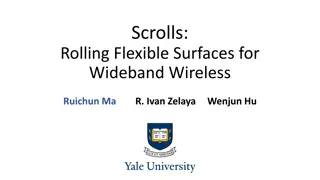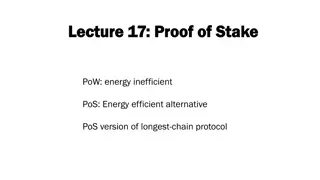Senior Design Project: Digi-Pow Wireless Power Meter Schematics and Solutions
This project entails the design and implementation of a wireless power meter system, utilizing capacitive power supply, RC circuits, diodes for power isolation, and software for data collection and display. Challenges include circuit size reduction, switch debouncing, and dual power-supply operation. The system features foreground and background processes for data calculation, dual power supply compatibility, XBee data reception, and LCD display output. The project culminates in a detailed final packaging for the system.
Uploaded on Mar 10, 2025 | 1 Views
Download Presentation

Please find below an Image/Link to download the presentation.
The content on the website is provided AS IS for your information and personal use only. It may not be sold, licensed, or shared on other websites without obtaining consent from the author.If you encounter any issues during the download, it is possible that the publisher has removed the file from their server.
You are allowed to download the files provided on this website for personal or commercial use, subject to the condition that they are used lawfully. All files are the property of their respective owners.
The content on the website is provided AS IS for your information and personal use only. It may not be sold, licensed, or shared on other websites without obtaining consent from the author.
E N D
Presentation Transcript
By: Kellen Denny Eric Iraheta Email: kellendenny@ufl.edu eiraheta@ufl.edu Phone: 850-212-5989 954-232-4721 EEL4924 Senior Design Digi-Pow Wireless Power meter
Solutions Usage of capacitive power supply; only monitoring current on live line Usage of RC circuit with pull down resistor Usage of diodes to isolate power from either batteries or the wall Implemented simple software DC filter Created/worked with a MATLAB function to collect data from an image Obstacles Trouble reducing overall circuit size within packaging Debouncing push-button switches Correct operation of dual power-supply for remote device Analog front end DC bias offset Bitmap image usage in LCD screen
TX Side Two processes: Foreground and Background. Foreground runs the initializations and the calculations on one second span of samples. Background process is triggered every time the ADC has a sample. Accumulates values into registers. Notifies foreground when one second of samples is collected. Foreground sends final calculated data via UART to the remote receiver RX Side Dual power supply capability (Wall outlet or AAA batteries) Push-button switches send signal as to which data is being asked for Receives data from XBee via UART interface Data is collected and distributed with the help of arrays via software Final data collected is then displayed on LCD screen; drawn pixel-by-pixel with the help of LCD driver library created in Code Composer Studio Implementations























